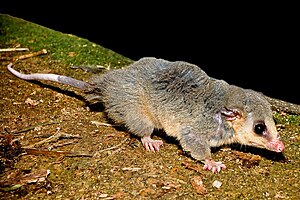Woolly dwarf bag rats
| Woolly dwarf bag rats | ||||||||||||
|---|---|---|---|---|---|---|---|---|---|---|---|---|

Micoureus sp. |
||||||||||||
| Systematics | ||||||||||||
|
||||||||||||
| Scientific name | ||||||||||||
| Micoureus | ||||||||||||
| Lesson , 1842 |
The woolly dwarf sac rats ( Micoureus ) are a subgenus of the dwarf sac rats ( Marmosa ). They are native to Central and South America.
General
Woolly dwarf pouch rats are mouse-like marsupials that do not have a pouch. Their fur is gray or brown on the upper side, the underside is lighter, often whitish. Like all smaller opossum rats, they have large eyes, pointed snouts, and large ears. As the name suggests, they are characterized by a striking, dense, woolly fur. These animals reach a head body length of 12 to 21 centimeters and a tail length of 17 to 27 centimeters.
The habitat of these opossum rats are predominantly forests. They are nocturnal loners who mostly live in the trees, but sometimes also come to the ground. During the day they sleep in nests made of leaves and twigs. They are omnivores that primarily eat insects and fruits.
Since the females do not have a bag, they drag the young around with them in the first months of life, hanging on their 9 to 15 teats. As with all opossum rats, the gestation period should be short and the litter size high.
The animals are not followed directly by humans, but suffer from the loss of habitat due to forest clearing.
Systematics
Until recently, these animals were classified in the genus of the dwarf sac rats ( Marmosa ). Due to the dense fur, differences in the structure of the skull and the lack of a gland on the throat, they are now listed as a separate genus.
Today at least six types are distinguished:
- Alston's woolly dwarf bag rat ( Marmosa alstoni )
- White-bellied woolly dwarf bag rat ( Marmosa constantiae ), synonym: M. demerarae
- Tates woolly dwarf bag rat ( Marmosa paraguayana )
- Small woolly pygmy-pouch rat ( Marmosa phaea )
- Marmosa rapposa
- Bare-tailed woolly dwarf bag rat ( Marmosa rutteri )
literature
- Nowak, Ronald M .: Walker's Mammals of the World . Johns Hopkins University Press, 1999 ISBN 0-8018-5789-9
Individual evidence
- ↑ RS Voss, SA Jansa: Phylogenetic relationships and classification of didelphid marsupials, an extant radiation of New World metatherian mammals. In: Bulletin of the American Museum of Natural History. 322, 2009, pp. 1-177. doi: 10.1206 / 322.1
- ↑ a b c Robert S. Voss, David W. Fleck and Sharon A. Jansa: Mammalian Diversity and Matses Ethnomammalogy in Amazonian Peru Part 3: Marsupials (Didelphimorphia) Bulletin of the American Museum of Natural History, 2019 (432): 1- 90. doi: 10.1206 / 0003-0090.432.1.1 , pages 27-32.